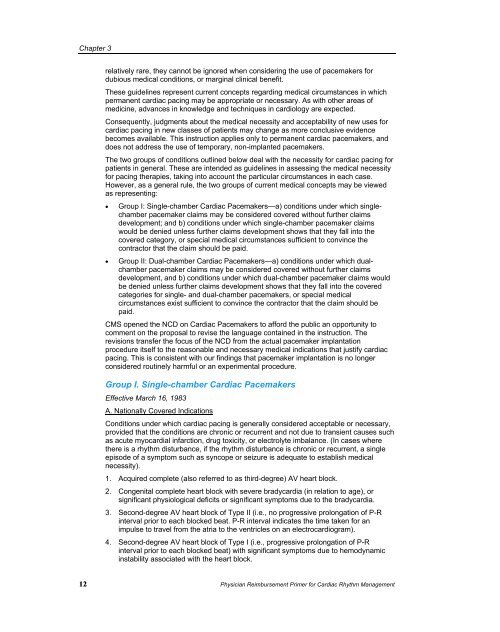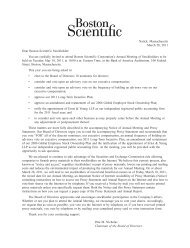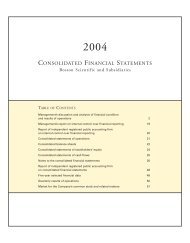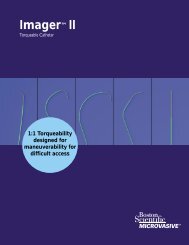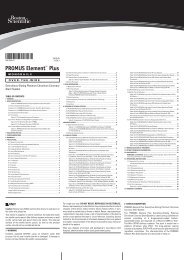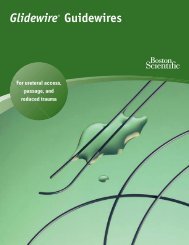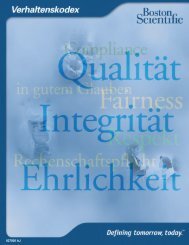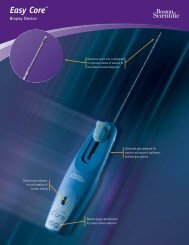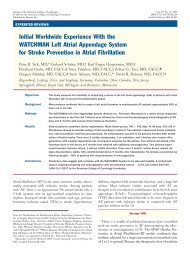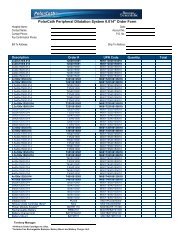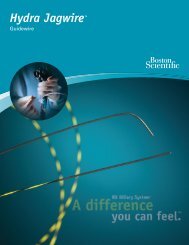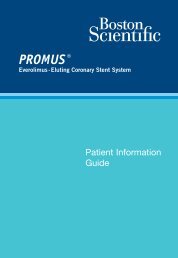Physician Reimbursement Primer for Cardiac ... - Boston Scientific
Physician Reimbursement Primer for Cardiac ... - Boston Scientific
Physician Reimbursement Primer for Cardiac ... - Boston Scientific
Create successful ePaper yourself
Turn your PDF publications into a flip-book with our unique Google optimized e-Paper software.
Chapter 3<br />
relatively rare, they cannot be ignored when considering the use of pacemakers <strong>for</strong><br />
dubious medical conditions, or marginal clinical benefit.<br />
These guidelines represent current concepts regarding medical circumstances in which<br />
permanent cardiac pacing may be appropriate or necessary. As with other areas of<br />
medicine, advances in knowledge and techniques in cardiology are expected.<br />
Consequently, judgments about the medical necessity and acceptability of new uses <strong>for</strong><br />
cardiac pacing in new classes of patients may change as more conclusive evidence<br />
becomes available. This instruction applies only to permanent cardiac pacemakers, and<br />
does not address the use of temporary, non-implanted pacemakers.<br />
The two groups of conditions outlined below deal with the necessity <strong>for</strong> cardiac pacing <strong>for</strong><br />
patients in general. These are intended as guidelines in assessing the medical necessity<br />
<strong>for</strong> pacing therapies, taking into account the particular circumstances in each case.<br />
However, as a general rule, the two groups of current medical concepts may be viewed<br />
as representing:<br />
• Group I: Single-chamber <strong>Cardiac</strong> Pacemakers—a) conditions under which singlechamber<br />
pacemaker claims may be considered covered without further claims<br />
development; and b) conditions under which single-chamber pacemaker claims<br />
would be denied unless further claims development shows that they fall into the<br />
covered category, or special medical circumstances sufficient to convince the<br />
contractor that the claim should be paid.<br />
• Group II: Dual-chamber <strong>Cardiac</strong> Pacemakers—a) conditions under which dualchamber<br />
pacemaker claims may be considered covered without further claims<br />
development, and b) conditions under which dual-chamber pacemaker claims would<br />
be denied unless further claims development shows that they fall into the covered<br />
categories <strong>for</strong> single- and dual-chamber pacemakers, or special medical<br />
circumstances exist sufficient to convince the contractor that the claim should be<br />
paid.<br />
CMS opened the NCD on <strong>Cardiac</strong> Pacemakers to af<strong>for</strong>d the public an opportunity to<br />
comment on the proposal to revise the language contained in the instruction. The<br />
revisions transfer the focus of the NCD from the actual pacemaker implantation<br />
procedure itself to the reasonable and necessary medical indications that justify cardiac<br />
pacing. This is consistent with our findings that pacemaker implantation is no longer<br />
considered routinely harmful or an experimental procedure.<br />
Group I. Single-chamber <strong>Cardiac</strong> Pacemakers<br />
Effective March 16, 1983<br />
A. Nationally Covered Indications<br />
Conditions under which cardiac pacing is generally considered acceptable or necessary,<br />
provided that the conditions are chronic or recurrent and not due to transient causes such<br />
as acute myocardial infarction, drug toxicity, or electrolyte imbalance. (In cases where<br />
there is a rhythm disturbance, if the rhythm disturbance is chronic or recurrent, a single<br />
episode of a symptom such as syncope or seizure is adequate to establish medical<br />
necessity).<br />
1. Acquired complete (also referred to as third-degree) AV heart block.<br />
2. Congenital complete heart block with severe bradycardia (in relation to age), or<br />
significant physiological deficits or significant symptoms due to the bradycardia.<br />
3. Second-degree AV heart block of Type II (i.e., no progressive prolongation of P-R<br />
interval prior to each blocked beat. P-R interval indicates the time taken <strong>for</strong> an<br />
impulse to travel from the atria to the ventricles on an electrocardiogram).<br />
4. Second-degree AV heart block of Type I (i.e., progressive prolongation of P-R<br />
interval prior to each blocked beat) with significant symptoms due to hemodynamic<br />
instability associated with the heart block.<br />
12 <strong>Physician</strong> <strong>Reimbursement</strong> <strong>Primer</strong> <strong>for</strong> <strong>Cardiac</strong> Rhythm Management


